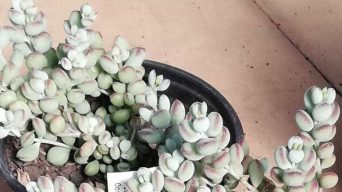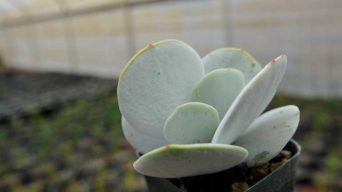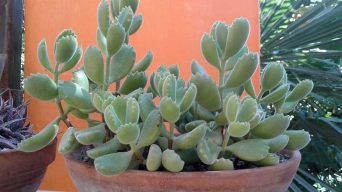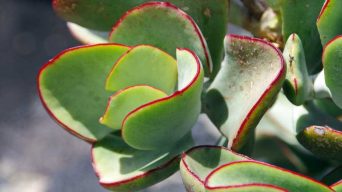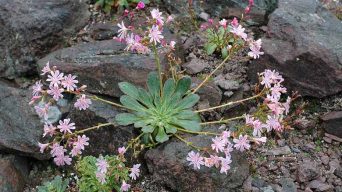The Cotyledon tomentosa ‘Bear’s Paw’ succulent plant is one of the most popular succulents that are also easy to grow.
It is especially popular among beginning succulent enthusiasts because the plant has thick leaves covered in thick hairs, giving it a fuzzy appearance.
This plant species is popular since it is relatively slow-growing and can adapt to a wide variety of conditions.
Growing succulents is a rewarding and relatively easy experience, but the proper conditions must be provided before planting succulents.
Getting off to the right start with your Bear Paw succulent will give it the best chance of thriving in its new home.
This article will go over how to properly care for and propagate the Cotyledon tomentosa ‘Bear’s Paw’ succulent plant.
Overview
The Cotyledon tomentosa is a perennial succulent native to South Africa’s Little Karoo region and belongs to the Crassulaceae family.
The Cotyledon tomentosa ‘Bear’s Paw’ is a very low-growing succulent that typically forms clumps with time. It is a small, slow-growing, and low-maintenance plant.
Cotyledon Tomentosa can grow up to 30 cm in height and width, but it prefers to stay around 10cm wide at maturity.
It has interesting leaves shaped like the imprint of a bear’s paw, hence the name Bear’s Paw.
The leaves are usually green but may also have a reddish tinge. These succulent leaves are fleshy, with white hair covering the surface of them.
Bear’s Paw flowers are available in white, pink, or purple. The flower blooms beautifully when mature and comes out on a tall stalk with an impressive size of up to 2 feet!
How To Care for Cotyledon Tomentosa (Bear’s Paw)
The Cotyledon tomentosa ‘Bear’s Paw’ succulent plant is not too hard to care for and has a lovely appearance.
It is also an easy-to-care-for succulent plant in the yard or a pot indoors.
Below you’ll find the most important information you need to know about caring for Cotyledon tomentosa ‘Bear’s Paw’ to keep it looking excellent and thriving.
Sun Exposure & Light Requirements
The Cotyledon tomentosa ‘Bear’s Paw’ succulent plant thrives in full sun to partial shade.
In the wild, they usually grow under trees or shrubs that provide some protection from the sun’s harsh rays during the summer months when it is at its hottest and brightest.
Indoors, place your plants near a west-facing or east-facing window that gets plenty of bright, indirect light. Avoid direct sunlight and provide partial shade outdoors, especially during the hottest parts of the day.
Watering Requirements
Bear’s Paw succulent plant (Cotyledon tomentosa) is one of the easiest succulent plants to care for. It can survive in almost any condition. With proper care, it is easily capable of growing without the need for attention.
It will do best when watered once a week and allowed to dry out between waterings. The Bear Paw plant does not require much water, and when overwatered, it can develop root rot.
Only water when the soil is dry, but before it starts to shrivel. Bear’s Paw succulent plant also needs to be watered deeply so that water penetrates deep within the soil.
Avoid getting any water on the plant’s leaves if possible because this will cause them to rot quickly.
Soil Requirements
As is true for most succulent plants, the Cotyledon tomentosa ‘Bear’s Paw’ grows best in porous soil.
The mix should be fast draining so it does not remain saturated with water for long periods, but it should retain enough moisture so that the plant can take up any nutrients presented before moving on.
Use a well-draining soil mix made from cactus soil or any other high-quality potting mix and perlite for the best results.
You can also mix your succulent soil by combining equal parts of potting soil and perlite to create a well-draining but nutrient-rich base for your Cotyledon tomentosa ‘Bear’s Paw’.
If you are having trouble making your own soil mix, purchase cactus soil or succulent soil mix to plant your Cotyledon tomentosa ‘Bear’s Paw’ plants.
Temperature and Humidity
The Cotyledon tomentosa ‘Bear’s Paw’ succulent plant is not tolerant of cold temperatures.
It does not like drafts or extremely windy conditions, so protect it from both of these when possible.
The Cotyledon tomentosa ‘Bear’s Paw’ succulent plant is intolerant of hot temperatures. I
t can even become susceptible to rot when exposed to excessively high temperatures for too long.
When the plant is active (the warmer months of the year), the ideal temperature range would be 68° – 80° Fahrenheit (20 – 27°C).
When the plant is dormant (the colder months of the year), the ideal temperature range would be 50° – 70° Fahrenheit (10 – 21°C).
The average humidity requirements for this plant are around 40%.
Fertilizing
Cotyledon tomentosa ‘Bear’s Paw’ succulent plant does not need to be fertilized often. It can benefit from occasional fertilization in the growing season (spring and summer).
If you want to use a fertilizer, go with a balanced liquid fertilizer diluted to half-strength. Never use full strength on Cotyledon tomentosa as this can burn it.
If your Cotyledon tomentosa ‘Bear’s Paw’ is outdoors, try and fertilize it about once a month during the growing season (spring and summer).
Take care of putting fertilizer on the leaves directly because they can get burnt very easily.
If you notice that its leaves start curling or turning yellow, that’s a sign of over-fertilization! Take out the fertilizer immediately.
If your Cotyledon tomentosa ‘Bear’s Paw’ is indoors or inside a greenhouse, try fertilizing it once every two months during the growing season.
If you fertilize it outside of the growing season, only do it about once every 2-3 months.
Potting and Repotting
The Cotyledon tomentosa ‘Bear’s Paw’ succulent plant requires little care and rarely needs to be repotted, but if grown in a small pot for a long time, it will eventually become rootbound.
Repotting should occur every few years or once the plant becomes rootbound.
The best time to repot is usually in the spring when most succulents experience rapid growth.
The best type of pot is a wide, shallow pot because it encourages faster growth. It also needs good drainage and a growing medium that retains a lot of moisture while draining quickly.
If you notice rotten roots or leaves discoloration or slow growth, then it may need repotting. The Bear’s Paw succulent looks best in a clay pot with good drainage.
Repotting should be done gradually by removing some soil before putting new soil in the new pot. This allows time for the roots to adjust.
Don’t water it for a few days after repotting, and place the plant where it will get good light, but not full sunlight all day long, as this can cause burning of the leaves.
Pruning
The Cotyledon tomentosa ‘Bear’s Paw’ succulent plant usually does not require pruning except for removing dead leaves or old stems.
Since they grow out and downward, if planted directly into the soil and allowed to find their own spot, they will need some grooming done on occasion to keep them looking their best.
If you prune them and cut off the tip of any stem, it will often result in a desirable new side shoot growing from where you made your cut.
If pruned, Cotyledon tomentosa ‘Bear’s Paw’ succulent plants should be pruned back by at least half to three-quarters of their height or more.
They tend to develop a strong trunk as they mature, but if you want them to look more full and bushy, it would be best not to allow them to grow so tall.
If left alone naturally, the Bear’s Paw succulent tends to branch from its base wider upon the plant, which results in a more V-shaped growth pattern.
If you want to grow this Cotyledon tomentosa ‘Bear’s Paw’ succulent plant in a hanging basket, keeping it trimmed back a bit and ensuring your pot design allows for adequate drainage.
Plants that are naturally exposed to the elements tend not to need much pruning.
If you are growing Cotyledon tomentosa succulent plants in containers, they require frequent trimming not to get too large.
Be sure always to remove any dead leaves and stems before you prune your Bear’s Paw succulent back or maintain its shape in a container.
Pests and Diseases
The Cotyledon tomentosa ‘Bear’s Paw’ succulent plant is susceptible to pests and diseases like most other succulents.
These include mealybugs, spider mites, and scale as the common pests, and fungal diseases as the most common ailments.
In addition to these issues, the stems of this plant are susceptible to rot if they stay moist for too long.
Pests
Mealybugs
Mealybugs are a common pest for this plant and one of the easiest to identify.
Mealybugs look like small pieces of cotton (hence their name) stuck on the plant; they tend to cluster together, often near branch junctions or leaf nodes.
Mealybug infestations can be treated with an insecticidal soap spray or by dabbing the affected areas with rubbing alcohol.
If you’re experiencing an infestation, you should not stop treating your plant until the mealybugs are gone; these insects tend to lay eggs in their cottony masses and will return if not completely wiped out.
Spider Mites
The spider mite is a tiny, eight-legged insect that will leave behind telltale signs of infestation: fine silk webbing.
Like mealybugs, they cluster together and can be wiped out by an all-purpose houseplant pesticide or insecticidal soap spray.
Scale Insects
Scales, like mealybugs, are small and often clustered. These insects secrete a waxy covering over their bodies, making it hard to wipe them out with alcohol or insecticidal soap.
The easiest way of dealing with scale is by simply dabbing them away with an old toothbrush dipped in rubbing alcohol and then wiping down the leaf with a cotton ball dipped in soapy water.
Diseases
Root Rot
The common fungus affecting succulents is root rot. Root rot can be caused by several things, including over-watering and having a pot that’s too small for the plant.
Having well-draining soil is key to avoiding this fungus, making sure your plant never stays wet for long.
If you notice water droplets on your plant’s leaves after watering it, move it to a sunnier area and do not water again until the soil dries out.
Root rot is easily treated with a fungicide powder or by completely removing the affected plant matter and replanting.
Make sure never to let this happen again by using a larger pot for your succulence and ensuring that your soil drains well.
Powdery Mildew
Another common fungus that affects succulents is powdery mildew, a grayish fungus that can be wiped away with a cotton swab or fungicidal soap spray.
This fungus only affects the leaves and will not harm your plant if treated early on.
Powdery mildew can be avoided by washing your plant’s leaves often, ensuring it gets plenty of airflow, and rotating its position every few weeks.
How to Care for Cotyledon Tomentosa (Bear’s Paw) in Winter
The Cotyledon tomentosa ‘Bear’s Paw’ is a perennial succulent that can be grown indoors and outdoors.
It does not tolerate cold very well, so if you are growing it outdoors, make sure to bring the plant inside before there is a chance of frost.
If your winter temperatures are milder, then you can also grow the plant throughout the year outdoors.
But for people living in areas where there is frost, to protect the plants during the winter, you must bring it indoors before the temperature gets to 40°F (5°C).
You should start this process when low nighttime temperatures are around 50°F (10°C) since these plants will not do well once the temperature drops below 40°F (5°C).
You should have a greenhouse or a bright, sunny window to grow the plant indoors.
If you cannot provide them with enough light, then the leaves will begin to show rolling of the edges and die back along with becoming a reddish color.
If indoor conditions do not offer warm temperatures, you may need to purchase a grow lamp for this plant.
During the winter months, you will want to keep the soil slightly drier so that you do not get any rotting.
In addition, since these plants are growing in a colder environment during winter, they will become more dormant and not grow very fast, so be careful about over-watering.
In early spring, when there is no longer any danger of frost and the temperature is rising, you should move the plants back outdoors.
How To Propagate Cotyledon Tomentosa (Bear’s Paw)
If you wish to propagate Cotyledon Tomentosa ‘Bear’s Paw’ succulent plants, there are two methods you can use – cuttings and seeds.
Cuttings
To propagate Cotyledon Tomentosa ‘Bear’s Paw’ stem cuttings:
- Prepare a pot with cactus soil.
- Remove the lowest leaves from each cutting so that only 0.5 cm of the leaf remains at the end of the cutting. Use sharp scissors to make your cuts.
- Place your ready-to-plant succulent cuttings into the cactus soil and cover them with a thin layer of sand or succulent soil mix.
- Water gently and place in a sunny area to allow your cuttings to callous and form roots.
- Once the roots form, plant your baby succulents in their own pots.
Seeds
To propagate Cotyledon Tomentosa ‘Bear’s Paw’ seeds:
- Choose a pot that has drainage holes and fill it with cactus soil.
- Moisten the soil, then sprinkle your Cotyledon Tomentosa ‘Bear’s Paw’ seeds on top of well-moistened soil (not dripping wet). Cover the seeds lightly, but ensure they’re still visible.
- Water well by spraying or dribbling water in a fine mist.
- Keep in a sunny area and keep the soil moist and warm but not sopping wet or dry.
- After about three weeks, your seeds should have germinated. Transplant into their own pots when they’re big enough to handle.
Is the Cotyledon Tomentosa (Bear’s Paw) Toxic?
Yes, the Cotyledon Tomentosa is toxic. The sap of this plant is known to cause skin irritation in some people. If consumed, it may cause digestive upset or vomiting.
All parts of this plant are considered to be toxic, especially the leaves.
It’s recommended to take caution when handling this plant to minimize the risk of exposure and never ingest any part of the plant.
Children or pets should not handle it without safety gloves after washing their hands with soap and water.
Final Thoughts
Growing succulents is fun and easy.
The Cotyledon tomentosa ‘Bear’s Paw’ succulent plant is an excellent specimen for someone who wants to grow an interesting-looking plant that does not require much attention.
The Cotyledon tomentosa ‘Bear’s Paw’ succulent plant is also suitable for growing in groupings because of how it looks with its clustering habit.
For the reasons mentioned above, this plant is good to try if you are curious about growing succulents and do not want to invest much time or effort into their care.


